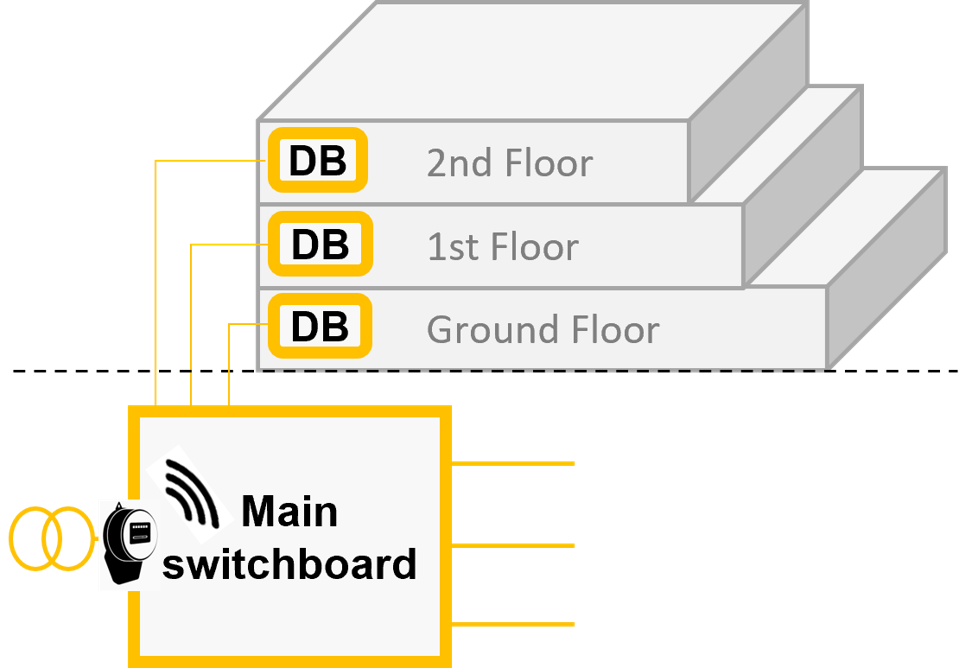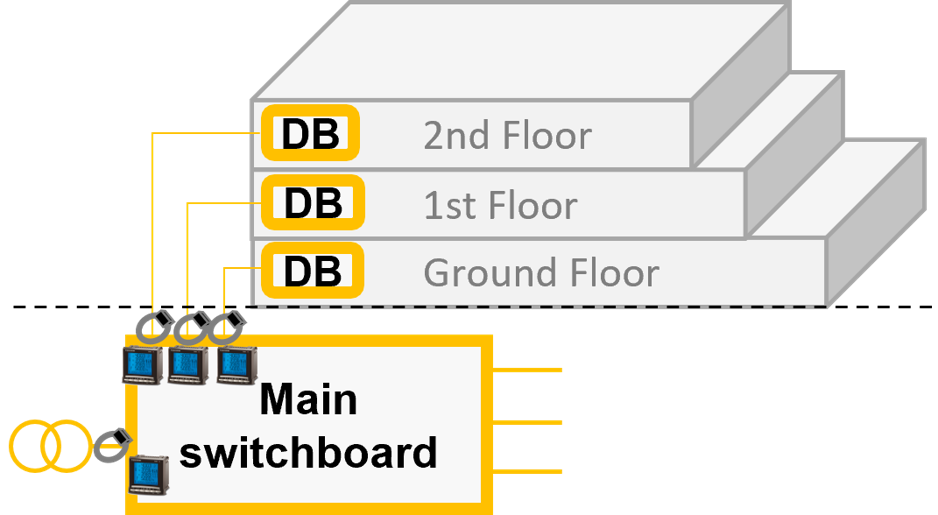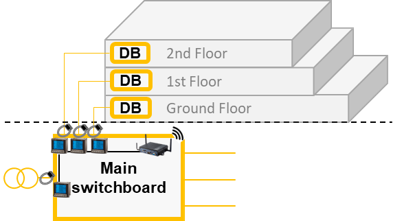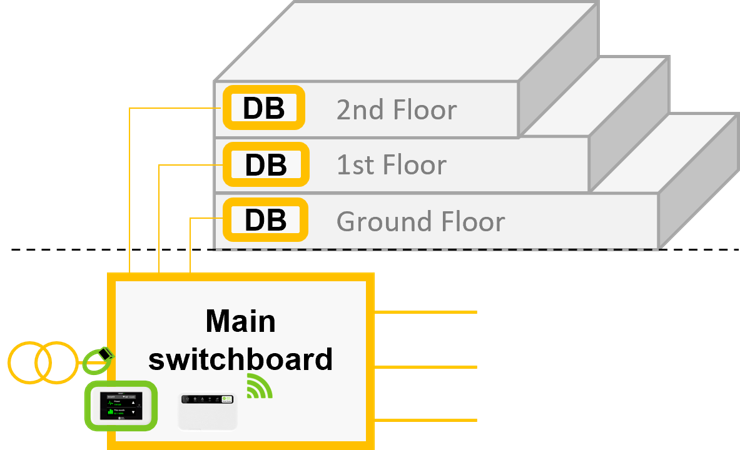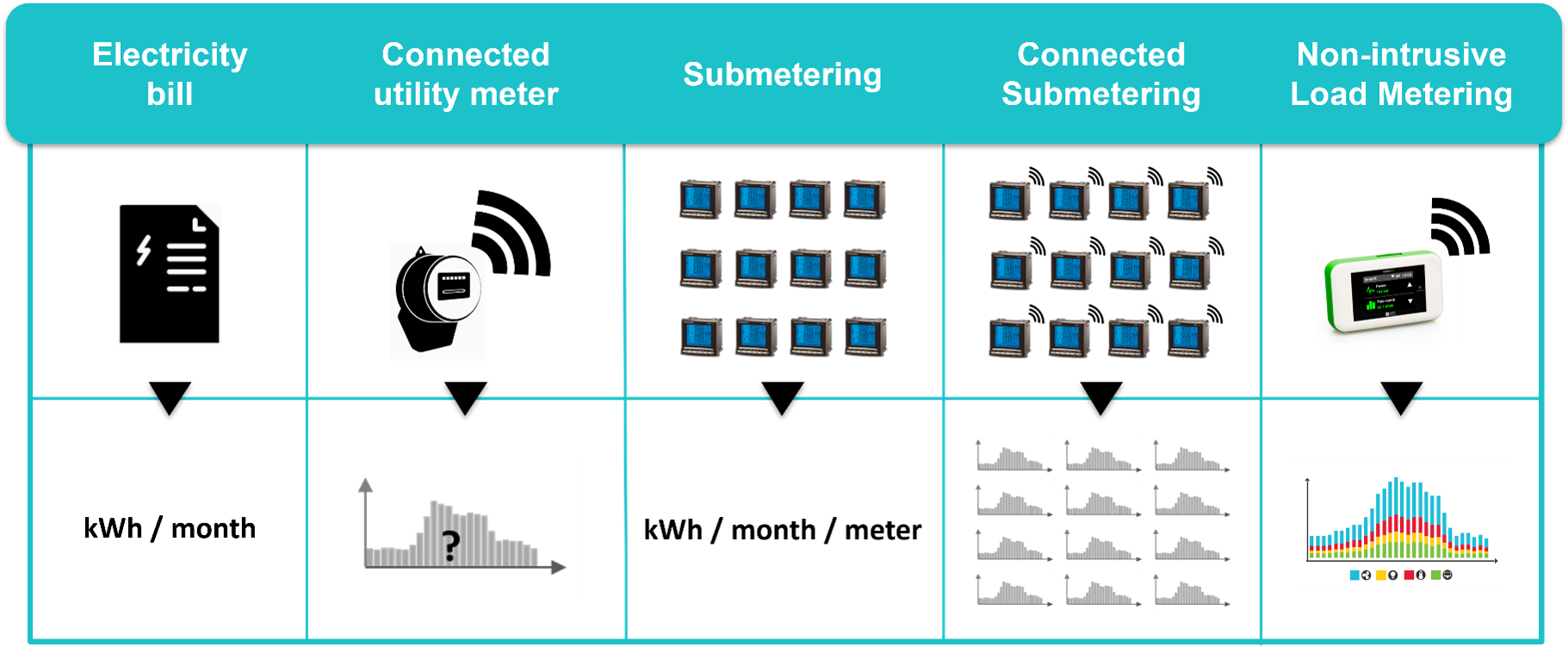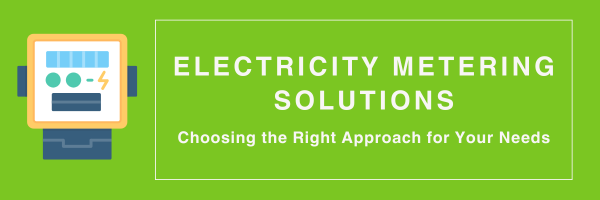
Electricity Metering Solutions: Choosing the Right Approach for Your Needs
Effective energy management is the cornerstone of a sustainable future, and the ability to measure energy consumption is critical to optimising energy use. As Lord Kelvin, the British physicist, famously said, “If you cannot measure it, you cannot improve it.” This principle applies perfectly to energy management. Whether in a residential building, office, or industrial complex, choosing the right electricity metering solution to understand your consumption is the first step toward improving energy efficiency and reducing costs.
In this article, we will explore the various electricity metering solutions available for measuring electricity consumption, discussing their purposes, costs, and limitations. We will then explain why non-intrusive load monitoring (NILM) stands out as the most efficient and scalable solution for modern energy management.
The Different Types of Electricity Metering Solutions
Electricity Bills (Utility Metering)
Electricity bills provide the most basic form of energy measurement, offering a general overview of a building’s total energy consumption over a specific period. While they are widely available and cost nothing beyond the energy used, they lack the level of detail needed to make precise energy-saving decisions.
For what purpose?
The most basic form of energy measurement is utility metering, which is reflected in monthly electricity bills. These bills provide an overview of your total energy consumption over a specific period, typically on a monthly basis. This is helpful for identifying general trends in electricity usage and for budgeting purposes.
Electricity bills can also serve as a first step in identifying opportunities for cost savings, such as recognising discrepancies between your subscribed power and actual consumption. If the building’s usage deviates significantly from the subscribed power, adjusting the subscription can optimise costs.
Cost:
The information provided on the bill is usually free, as it is generated by your electricity supplier. However, there may be additional costs associated with manually entering this data into spreadsheets for performance tracking. Using external platforms to analyse this data further would also incur costs.
Limitations:
While electricity bills offer a high-level overview, they are limited in the level of detail they provide. For example, they don’t break down energy use by individual systems or specific times of the day, making it difficult to identify where energy savings can be made. Furthermore, electricity bills are delayed, so they only offer historical data rather than real-time insights.
Connected Utility Meters
Connected utility meters offer a more detailed look at electricity consumption by providing detailed data at shorter intervals, typically every 10 minutes. This additional granularity allows for better monitoring of energy use patterns and helps detect inefficiencies.
For what purpose?
Connected utility meters go beyond traditional utility metering by allowing more frequent and detailed tracking of energy usage. These meters capture data at shorter intervals (such as every 10 minutes) and provide the “load curve,” which helps analyse consumption patterns in real-time.
These meters can be directly connected to a building’s energy management system, allowing facility managers to monitor fluctuations in energy consumption and make more informed decisions about energy use and costs.
Cost:
The cost of connected utility meters can vary, depending on the technology and the level of integration with energy management systems. Typically, the costs include the price of the meter itself, installation, and the software platform used to monitor and analyse the data. Additionally, there might be ongoing platform licensing or subscription fees.
Limitations:
While connected utility meters offer more granular data than electricity bills, they still fail to provide detailed information about specific equipment or individual zones within a building. These meters also only measure the overall consumption, without giving insight into the causes of peak usage or overconsumption.
*Example of a metering plan with a connected utility meter.
Submetering
Submetering improves standard metering solutions by allowing users to track energy consumption for specific areas or equipment within a building. This enables building managers to identify inefficiencies and implement targeted energy-saving measures.
For what purpose?
Submetering involves installing dedicated meters on different circuits or zones within a building to track energy use at a more detailed level. For example, submetering by zone allows facility managers to monitor energy consumption on a floor-by-floor basis, while submetering by equipment type provides insights into the energy usage of specific systems (such as HVAC, lighting, or IT equipment).
This type of measurement enables building managers to understand where energy is being consumed most and helps identify areas that require optimisation.
Cost:
Submetering requires the purchase and installation of meters on each circuit or zone, which can be expensive, particularly in large buildings or facilities with many electrical systems. Installation costs are typically higher, as electricians must visit each sub-circuit to install the meters. In addition, regular maintenance is needed to ensure that the data remains reliable.
Limitations:
Submetering is an effective way to gain more detailed data, but it can be costly and complex to install, especially in older buildings with outdated electrical infrastructure. For buildings with a large number of circuits or zones, submetering can become difficult to manage and scale. Additionally, the data provided by submeters requires manual intervention and regular maintenance to ensure its accuracy.
*In this metering plan example, 4 sub-meters are required to obtain a measurement of consumptions
per zone (1 for the general entry and 3 for the floors).
Connected Submetering
Connected submetering enhances traditional submetering by allowing real-time data collection and remote monitoring. This makes it easier to analyse energy consumption patterns without needing manual data entry or physical meter readings.
For what purpose?
Connected submetering takes submetering to the next level by allowing real-time remote reading of the energy consumption data. These systems are connected to a central hub, enabling facility managers to view consumption patterns across the building in real-time, regardless of where they are located.
This technology is particularly useful for large facilities or multi-site operations, where traditional submetering would require extensive manpower to read and monitor data manually. Connected submetering also allows for more sophisticated analysis, helping to identify energy savings opportunities more easily.
Cost:
The cost of connected submetering is higher than that of standard submetering due to the cost of the communication infrastructure (such as gateways, communication modules, and software platforms). Installation and maintenance costs are also higher due to the added complexity of the system. However, these costs are often outweighed by the operational efficiencies and energy savings identified through real-time monitoring.
Limitations:
While connected submetering offers significant benefits in terms of real-time monitoring, it still requires a substantial initial investment in both hardware and software. Additionally, for very large or complex buildings, the data generated can become overwhelming, requiring sophisticated data processing and analysis tools to make sense of the information.
*In this example, the 4 sub-meters allow a measurement per zone are connected to a gateway to centralise
and communicate the measured data.
Non-Intrusive Load Monitoring (NILM)
Non-intrusive load monitoring (NILM) represents a breakthrough in smart metering by providing highly detailed energy consumption insights with minimal hardware requirements. It uses machine learning algorithms to disaggregate electricity consumption into individual appliances without requiring additional sensors.
*This example shows that with non-intrusive monitoring, it is sufficient to install a single non-intrusive meter (Smart X)
at the level of the general electrical supply. This meter communicates wirelessly via a router.
For what purpose?
Non-intrusive load monitoring (NILM) is an advanced technology that analyses energy consumption by end-use by installing a smart meter at the main power supply. Rather than installing multiple submeters across various circuits, NILM uses advanced algorithms to disaggregate the total energy usage into specific appliances and systems based on their electrical signatures.
For example, this allows facility managers to track energy consumption for individual equipment or zones without intrusive installations. NILM provides a highly granular and real-time view of energy use, enabling quick identification of inefficiencies or faulty equipment.
Cost:
NILM is cost-effective compared to traditional submetering systems because it requires only one single meter at the main power supply. The installation process is fast and non-intrusive, with no need for complex electrical work or additional submeters on each circuit. Although NILM solutions often require cloud-based platforms or subscriptions for data analysis, they are still significantly more affordable than connected submetering.
Limitations:
NILM’s primary limitation lies in the accuracy of its algorithms based on AI, which can vary depending on the complexity of the site and the number of devices involved. While NILM is effective for many applications, it may struggle in buildings with high amounts of electrical noise or complex systems that use similar power signatures.
Non-Intrusive Load Monitoring (NILM): A Key Electricity Metering Solution for Scalable Energy Management
Non-intrusive load monitoring (NILM) stands out among the various electricity metering solutions because of its ability to deliver high-quality, real-time data at a fraction of the cost of other solutions like connected submetering. Here’s why it’s the best choice for most businesses and building managers:
- Ease of Installation: NILM requires only one smart meter at the main electrical supply, making installation quick and non-disruptive.
- Cost-Effective: There is no need for expensive hardware installations across every circuit or zone, reducing initial setup costs.
- Scalability: NILM can easily be deployed across multiple buildings or locations, providing consistent data that can be compared across sites.
- Real-Time Insights: It provides continuous, real-time data, allowing for proactive energy management and optimisation.
- Reduced Maintenance: Unlike traditional submetering, NILM doesn’t require constant maintenance or manual data collection.
Conclusion
With the growing emphasis on energy efficiency and sustainability, choosing the right electricity metering solution is crucial for optimising energy consumption. While solutions like electricity bills, connected utility meters, and submetering have their place, non-intrusive load monitoring provides the most cost-effective, scalable, and efficient approach for modern energy management. By choosing NILM, businesses can ensure accurate, real-time energy data without the need for complex installations or ongoing maintenance.
For more information on how Smart Impulse‘s non-intrusive load monitoring technology can help optimise your energy management, contact us today.



